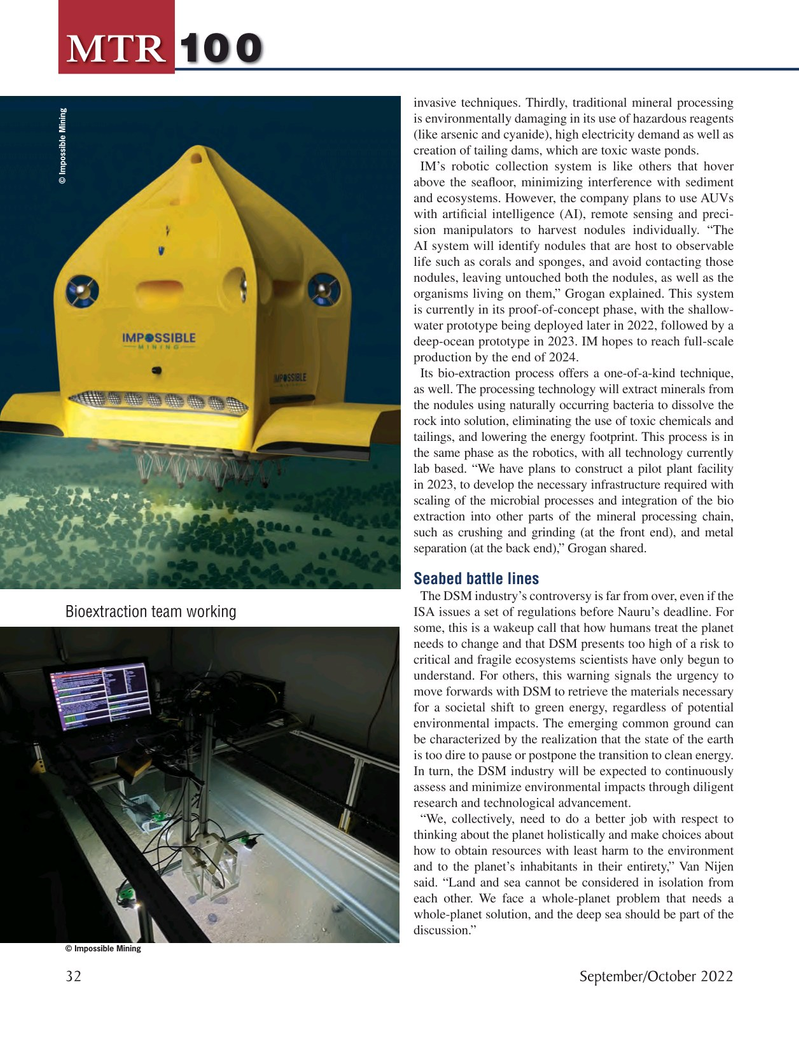
Page 32: of Marine Technology Magazine (September 2022)
Read this page in Pdf, Flash or Html5 edition of September 2022 Marine Technology Magazine
MTR 100 invasive techniques. Thirdly, traditional mineral processing is environmentally damaging in its use of hazardous reagents (like arsenic and cyanide), high electricity demand as well as creation of tailing dams, which are toxic waste ponds.
IM’s robotic collection system is like others that hover © Impossible Mining above the sea? oor, minimizing interference with sediment and ecosystems. However, the company plans to use AUVs with arti? cial intelligence (AI), remote sensing and preci- sion manipulators to harvest nodules individually. “The
AI system will identify nodules that are host to observable life such as corals and sponges, and avoid contacting those nodules, leaving untouched both the nodules, as well as the organisms living on them,” Grogan explained. This system is currently in its proof-of-concept phase, with the shallow- water prototype being deployed later in 2022, followed by a deep-ocean prototype in 2023. IM hopes to reach full-scale production by the end of 2024.
Its bio-extraction process offers a one-of-a-kind technique, as well. The processing technology will extract minerals from the nodules using naturally occurring bacteria to dissolve the rock into solution, eliminating the use of toxic chemicals and tailings, and lowering the energy footprint. This process is in the same phase as the robotics, with all technology currently lab based. “We have plans to construct a pilot plant facility in 2023, to develop the necessary infrastructure required with scaling of the microbial processes and integration of the bio extraction into other parts of the mineral processing chain, such as crushing and grinding (at the front end), and metal separation (at the back end),” Grogan shared.
Seabed battle lines
The DSM industry’s controversy is far from over, even if the
ISA issues a set of regulations before Nauru’s deadline. For
Bioextraction team working some, this is a wakeup call that how humans treat the planet needs to change and that DSM presents too high of a risk to critical and fragile ecosystems scientists have only begun to understand. For others, this warning signals the urgency to move forwards with DSM to retrieve the materials necessary for a societal shift to green energy, regardless of potential environmental impacts. The emerging common ground can be characterized by the realization that the state of the earth is too dire to pause or postpone the transition to clean energy.
In turn, the DSM industry will be expected to continuously assess and minimize environmental impacts through diligent research and technological advancement.
“We, collectively, need to do a better job with respect to thinking about the planet holistically and make choices about how to obtain resources with least harm to the environment and to the planet’s inhabitants in their entirety,” Van Nijen said. “Land and sea cannot be considered in isolation from each other. We face a whole-planet problem that needs a whole-planet solution, and the deep sea should be part of the discussion.” © Impossible Mining 32 September/October 2022
MTR #7 (18-33).indd 32 10/3/2022 8:20:08 AM

 31
31

 33
33
